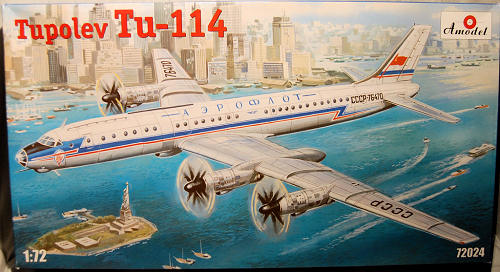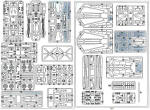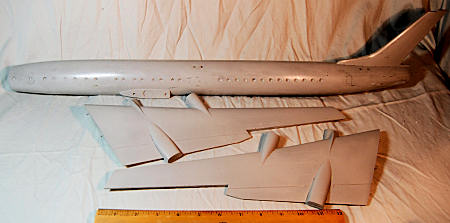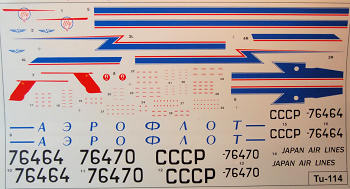
| KIT #: | 72024 |
| PRICE: | $275.00 SRP |
| DECALS: | Two options |
| REVIEWER: | Andrew Abshier |
| NOTES: | 440 parts total; epoxy-fibreglass fuselage and wings; limited-run injection molding |

| HISTORY |
In the history of aviation, it is hard to find
types that are truly unique. Most
good designs beget similar designs if the basic design is found to be sound,
which is why, as an example, so much of airliner service these days is by twin-engined,
conventional-layout aircraft such as the 737 and A320.
Fifty years ago, the Tu-114 broke the mold for airliner design--no
similar design has been built or even envisioned before or since--and the
tremendous size and sophistication of the design shocked aerospace observers
when the aircraft was first shown in the West in 1958.
The Tu-114 arose from a requirement issued to
the Tupolev design bureau in the early 1950s for a long-range intercontinental
transport based on the Tu-95 strategic bomber.
At that time in the
Tupolev incorporated the wings of the Tu-95
with a new fuselage and empannage designed to hold 220 passengers in an
all-tourist seating arrangement, though the usual arrangement was 120-150 seats
with a midships dining area, served, for the first time on any airliner design,
by a belowdecks galley. One
disadvantage of Tupolev's design was the very high positioning of the passenger
floor, almost 16 ft (4.9m) above the ramp.
The great cabin height made ground servicing a challenge, especially in
the early years of the type's service.
The first prototype, SSSR-L5611, flew for the
first time on
The Tu-114 entered revenue service in 1962 on
the Moscow-Khabarovsk route. In
1963 the Tu-114 began international services.
That same year, two Tu-114s were modified for very long range services
between
In 1967
As the newer Il-62 jets were introduced into
international service, Tu-114s were redeployed to domestic routes, where they
flew schedules until 1975.
Afterward, some Tu-114s were used as crew transports by the Soviet armed forces
until the type was ultimately retired in 1991.
Three Tu-114s still survive in museums in
| THE KIT |
 AModel
is no stranger to producing really large model kits in 1/72nd scale; this is
their 19th kit in the "AMonster" series.
If you've seen a 1/72nd 707-320B, B-52, or E-3A built up, you'll have an
idea of how large a model you'll get when the Tu-114 is completed.
"Big" doesn't even start to describe it; I put the Tu-114 next to my
in-progress Heller 707 and it made my model of the Boeing airliner look petite!
AModel
is no stranger to producing really large model kits in 1/72nd scale; this is
their 19th kit in the "AMonster" series.
If you've seen a 1/72nd 707-320B, B-52, or E-3A built up, you'll have an
idea of how large a model you'll get when the Tu-114 is completed.
"Big" doesn't even start to describe it; I put the Tu-114 next to my
in-progress Heller 707 and it made my model of the Boeing airliner look petite!
The very large box contains the three
fibreglass parts (fuselage and wings) with the smaller sprues bagged together.
The fibreglass casting is very well done with very restrained surface
detail; you will have to finish the seams on the fibreglass parts, but the
casting appears to not have any mismatches.
In spite of their size, the fibreglass parts are amazingly light and
strong and will form a good basic structure for the model.
The extreme ends of the fuselage--the nose to the level of the
 pilot's
seats and the tail cone--are cast as plastic parts, as are the tips of the wings
and vertical tail.
pilot's
seats and the tail cone--are cast as plastic parts, as are the tips of the wings
and vertical tail.
As for those plastic parts, they are cast in
AModel's typical low-pressure style.
Molding is generally very good--much better than I've seen in AModel kits
in the past--but there are a few sink marks in some of the larger parts that
will need cleanup. Surfaces are
very clean overall.
The flight deck is fully detailed for all 5
crew positions (pilots, radio operator, engineer, and navigator); add some
seatbelts and you're all set. No
cabin detail is provided, but you're not going to see much inside the fuselage
once built.
Clear parts are fairly good.
Polishing would definitely help, but the basic parts are reasonable.
All 70 cabin windows are provided, but thankfully are added from the
outside; assuming they fit well, this will save a ton of masking for sure!
Alternatively, the modeler can make the cabin windows from Humbrol
Clearfix or Microscale Crystal-Clear.
Landing gear and wheel wells are well molded.
The landing gear struts are extremely complex and careful study will be
needed to assemble the struts correctly.
I would advise building these up completely unpainted, so that all joins
have maximum strength--they're going to have to hold up this big SOB once built,
after all! The instructions call
for the gear to be trapped between the nacelle halves or nosewheel well sides;
on mine I'm going to convert them to trunion mounts so I can add the gear after
painting.
Nacelles are very detailed with realistic depth
on the intakes and exhausts; the exhausts also include fan disks at the base for
greater realism. The
contra-rotating propellers are cast to the spinners, so there won't be the
tedium of cementing in, and lining up, 32 propeller blades!
AModel really went to town on external details
including seperate door hinges, door handles, and every antenna seen on the
actual aircraft. There is not going
to be very much that the modeler will have to add to bring their model to life.
I haven't dryfitted my kit yet but AModel kits
typically require "modeling skill" to complete, meaning the fit is only fair at
best; Mach 2 it isn't, but don't anticipate Tamiya fit either.
I expect that the six-word mantra for success in building limited-run
kits will be required: dry fit, adjust, dry fit again!
Decals have never been AModels' best subject,
but they really dropped the ball here.
Two variations of the Aeroflot early 1960s livery are provided: a
straight Aeroflot aircraft and an Aeroflot/Japan Air Lines joint service
aircraft. Decal designer
"With the exception of a nicely chosen shade of
blue for the cheatlines, every single other thing about the decals is wrong,
wrong, wrong. Utterly, totally, and completely wrong. All of the lettering is
wrong (either shape, size, or color, or all three). Newer style Aeroflot winged
hammer & sickle logos are provided, which were not on the aircraft depicted (or
any other Tu-114s that I know of in the original scheme). The registration
letters & numbers are beyond horrid. Shapes are completely wrong. The big Soviet
flags on the tail are hopelessly wrong. You do get
 There are
some alternatives to the bad decal sheet.
Tu-114s in their later years of service flew the 1970s Aeroflot scheme
(darker blue fuselage stripe, dark blue Aeroflot titles); the title style for
this scheme is readily available, and could be made up relatively easily.
A much more hard-to-find alternative is to locate one of the 30 custom
decal sets for this kit produced by
There are
some alternatives to the bad decal sheet.
Tu-114s in their later years of service flew the 1970s Aeroflot scheme
(darker blue fuselage stripe, dark blue Aeroflot titles); the title style for
this scheme is readily available, and could be made up relatively easily.
A much more hard-to-find alternative is to locate one of the 30 custom
decal sets for this kit produced by
| CONCLUSIONS |
This will be a major undertaking for the
builder, but the finished product will not be touched for impressiveness (hey,
you always wanted an excuse to build that addition to your house, right?).
There was no airliner ever built or even conceived like the Tu-114, so
the completed model is going to be an attention-getter wherever it is shown.
Other than the decal sheet, AModel did a great job on this one.
Review sample courtesy of one very dinged
wallet via
| REFERENCES |
Davies, R.E.G.: Aeroflot: An Airline and Its
Aircraft. Paladwr Press, 1992
http://en.wikipedia.org/wiki/Tupolev_Tu-11
Tu-114 Photos on Airliners.netAndrew Abshier
If you would like your product reviewed fairly and quickly, please contact me or see other details in the Note to Contributors.